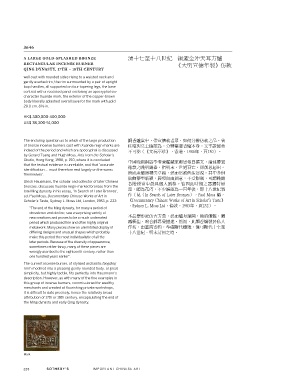Page 230 - 2019 October Important Chinese Art Sotheby's Hong Kong
P. 230
3646
A LARGE GOLD-SPLASHED BRONZE 清十七至十八世紀 銅灑金沖天耳方爐
RECTANGULAR INCENSE BURNER 《大明宣德年製》仿款
QING DYNASTY, 17TH – 18TH CENTURY
well cast with rounded sides rising to a waisted neck and
gently everted rim, the rim surmounted by a pair of upright
loop handles, all supported on four tapering legs, the base
centred with a recessed panel enclosing an apocryphal six-
character Xuande mark, the exterior of the copper-brown
body liberally splashed overall save for the mark with gold
20.8 cm, 8⅛ in.
HK$ 300,000-400,000
US$ 38,300-51,000
The enduring question as to which of the large production 銅香爐當中,帶宣德款者眾,如何分辨仿款之品。曾
of bronze incense burners cast with Xuande reign marks are 柱昭與莫士撝認為,分辨需憑香爐本身,文字證據並
indeed of the period and which are apocryphal is discussed 不可靠(《文玩萃珍》,香港,1986年,頁150)。
by Gerard Tsang and Hugh Moss, Arts from the Scholar’s
Studio, Hong Kong, 1986, p. 150, where it is concluded 中國晚期銅器學者兼鑑藏家郝思曼曾撰文,論述帶宣
that the textual evidence is unreliable, and that ‘accurate
identification ... must therefore rest largely on the wares 德款之晚明銅器,指明末,世道衰亡,卻創思層出,
themselves’. 所成金屬器精美卓越,然而常被低估忽視。其中多例
紋飾器型新穎,展現自由創意,不受限制,可謂晚期
Ulrich Hausmann, the scholar and collector of later Chinese 各階段當中最具個人風格。皆因此時期之器獨特紛
bronzes, discusses Xuande reign-marked bronzes from the
late Ming dynasty in his essay, ‘In Search of Later Bronzes’, 呈,頗為花巧,不少誤認為一百年後,即十八世紀製
ed. Paul Moss, Documentary Chinese Works of Art in 作(見〈In Search of Later Bronzes〉,Paul Moss 編,
Scholar’s Taste, Sydney L. Moss Ltd, London, 1983, p. 232: 《Documentary Chinese Works of Art in Scholar’s Taste》
,Sydney L. Moss Ltd,倫敦,1983年,頁232)。
“The end of the Ming dynasty, for many a period of
decadence and decline, saw a surprising variety of
new creations and proves to be a much underrated 本品器形近仿古方鼎,然而爐身渾圓,簡約優雅,觸
period which produced fine and often highly original 感極佳,吻合郝思曼描述。然而,此類香爐製於私人
metalwork. Many pieces show an uninhibited display of 作坊,由富商委約,準確斷代極難,僅可斷代十七至
differing designs and unusual shapes which probably 十八世紀、明末清初之時。
make this period the most individualistic of all the
later periods. Because of the diversity of appearance,
sometimes rather fancy, many of these pieces are
wrongly ascribed to the eighteenth century, rather than
one hundred years earlier”.
The current incense burner, of stylised archaistic fangding
form modified into a pleasing gently rounded body, of great
simplicity, but highly tactile, fits perfectly into Hausmann’s
description. However, as with many of the fine examples in
this group of incense burners, commissioned for wealthy
merchants and created at flourishing private workshops,
it is difficult to date precisely, hence the relatively broad
attribution of 17th or 18th century, encapsulating the end of
the Ming dynasty and early Qing dynasty.
Mark
228 SOTHEBY ’S IMPORTANT CHINESE ART

